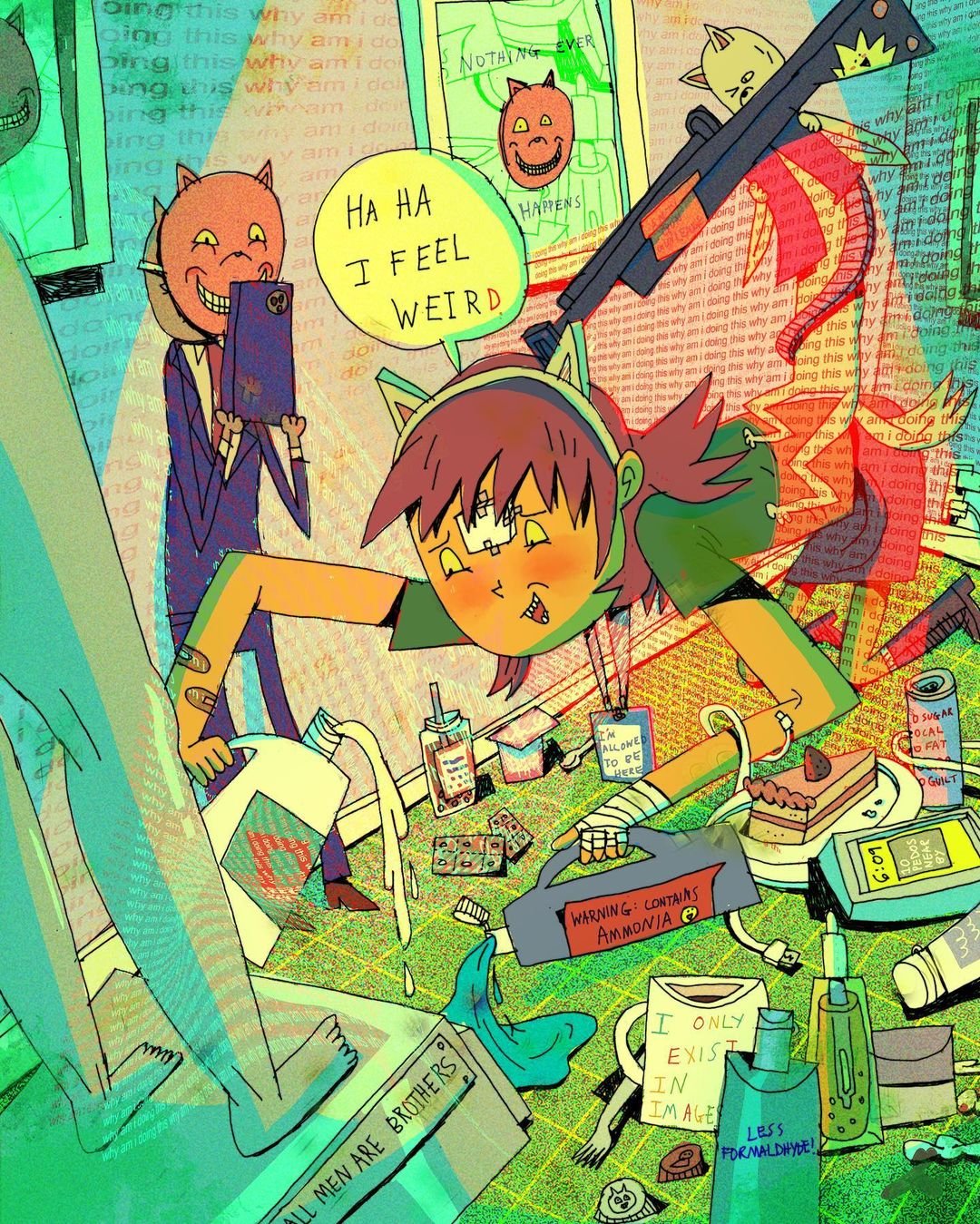NFT 101: THE GOOD, THE BAD & THE MISGUIDED

Few other terms have been thrown around and reigned the social media streams around the globe as much as “NFT” as of late. While stories about unbelievable profits and environmental concerns are making the rounds, RAMCPU shares his thoughts in an “101 Intro to”-style deep-dive, explaining key terms, weaknesses and opportunities of the emerging technology.
This article is part of the on-going series “RAMCPU for sabukaru”. Examining the intersection of art, information and aesthetics, RAMCPU shares his uniquely critical perspective on contemporary art and media to shape the discourse between various discipline and schools of thought.
A brief Intro to NFTs
Satoshi Nakamoto is said to be the person (or group of persons) responsible for the development of Bitcoin.
Bitcoin was the world's first cryptocurrency, and the technology surrounding it will likely shift the world of tech and art for centuries to come. Still, no one knows for sure who Nakamoto is or if they (as an individual) exist at all.
Machine Hallucinations Exhibition in Hong Kong by Rafik Anadol
Fast-forward to a related technology known as NFTs (aka non-fungible tokens):
These units of data are "tokenized" media (photos, media, audio, etc.). The tokens and their data are stored on a digital ledger known as the blockchain; these tokens contain, within its code, the proof of ownership that can be transferred between collectors.
This means that digital art (media) can be shared online, purchased with cryptocurrencies, and can have a verifiable owner. That owner can show “proof-of-ownership” of the digital asset and resell her original "copy" of the work (and in many cases, the original artist can automatically receive royalties for each resell through something known as "Smart-Contracts").
In addition, there has been a surge of NFT crypto-collectibles —digital tokens that function similar to real-life baseball cards or comic books. Disney and even the NBA have released their own NFTs over the past year. Anyone can create (or mint) an NFT—but the question of "will this catch on?" has expired: NFTs have already become mainstream (and they still have a long way to go).
Notable happenings in the NFT space
Digital artist Mike Winkelmann (aka Beeple) sells an "NFT Sculpture" for $29 Million.
Founder of Twitter, Jack Dorsey, sells his first tweet ever as an NFT for over 2.9 Million USD — which was reportedly donated to an Africa fund known as "Give Directly."
Nolan Bushnell, founder of Atari, releases a collection of Augmented Reality NFTs (designed by Zai Ortiz) to celebrate 50 years of Computer Space.
Artist and businessman Jay Z released his own NFT to commemorate the 25th anniversary of his legendary debut album "Reasonable Doubt."
These are just a few of the big happenings in the NFT space as more platforms make selling digital assets more accessible and affordable. Countless artists have already started minting their work on the blockchain.
THE BIG COST OF CRYPTO
Of course, this technological revolution is not without its critics. Implementation of this new technology is ridiculed mainly in relation to its perceived environmental costs. Since blockchain technology relies on an incredible amount of computing power and electricity to verify and facilitate transactions, some have gone as far as rejecting the usage of the technology entirely.
“I think its imperative people are hypercritical about the nature of crypto and don’t just buy into this utopia NFT is trying to paint. That being said, as people start to phase out less efficient and earlier generation coins, I could see a world where this is much less of a concern…In the best-case scenario, artists will be able to control the narrative of the value of Web3 and NFTs. I think we’re not too far off from the worst-case scenario right now; Over-hyped NFTs, boring over-commercialization and the same rich investor friend of friends falsely raising the value of work.”
NFTS AND ENERGY
When people address concerns about energy consumption in the crypto and NFT spaces, most of that data is contextualized based on comparisons to other industries. For example, Fortune Magazine reports,
"..Each Bitcoin transaction consumes 1,173 kilowatt-hours of electricity. That's the volume of energy that could "power the typical American home for six weeks...The Bitcoin mining that enables a purchase, sale, or transfer, it posits, uses a slug of electricity that costs $176."
Cryptocurrency mining location
In September of this year, the New York Times reported,
"The Bitcoin network uses about the same amount of electricity as Washington State does yearly…."
These comparative figures are commonly cited, and the conclusions drawn about the impact of crypto based on these excerpts are usually a result of false equivalence; a logical fallacy attempting to compare two things while ignoring the significant differences between them.
Here are some critical details that people who rail against NFTs for their perceived environmental costs tend to forget:
1) Unlike our current energy-draining fiat ecosystem— Crypto is a new, developing technology
As Rahul Sing for World Economic Forum explains:
“...an oft-repeated argument is that the carbon footprint of fiat money is not low, either. Fiat money has a secondary impact through maintaining thousands of bank branches, employees using fossil-fuel based transport to reach these offices (and more than 3.5 million ATMs worldwide soaking up power 24/7.) The fact that bitcoin is a relatively young technology is often lost in the debate. Bitcoin, like other cryptocurrencies, is evolving and will take a few years to mature. It will – especially with the push from recent developments – inch closer to being environmentally friendly.”
2) Not all cryptocurrencies are created equally…
Here are 15 more sustainable outlined by Leafscore, and here are the sustainability plans for highly anticipated crypto Ethereum 2.0.
3) Bitcoin transaction sizes are typically larger and less common than fiat transactions.
“Bitcoin uses 550,000 times as much electricity per transaction as Visa-- However, the number of transactions is a poor standard for judging the value exchanged on competing networks. Mastercard and Visa handle large numbers of small-dollar exchanges, whereas the Bitcoin transactions are $16,000 on average," says Diego Zuluaga, "With that in mind, if we compare Bitcoin and the card networks by the volume of transactions processed, a different picture emerges. The volume of Bitcoin transactions over the 24 hours to August 27 was $3.6 billion, which is not an outlier. That yields an annual transaction volume of $1.33 trillion. This is below Mastercard's approximate $6 trillion and Visa's $7.8 trillion in payments volume over 2017. But it is not orders of magnitude below...Whether electric power is consumed for the mining of cryptocurrency or the production of cars has no bearing on the environmental effects. Therefore, the impact of Bitcoin depends on two factors over which the network has no control: the way in which power is generated and how electricity is priced….
We can only conclude that reports of cryptocurrencies' wreaking environmental havoc have been greatly exaggerated. An examination of transaction volumes shows that Bitcoin's power use is not outside the league of intermediated payments systems.
4) The entire global economy and its relation to energy consumption needs to be reworked.
The comparative data about how much energy the NFT ecosystem uses fails to recognize how much energy, resources, and lives are disposed to power other long-standing (and often exploitive) industries that have been overdue for overhaul or elimination.
The dissolved website cryptoart.wtf was a tool built to reveal data on the energy use of crypto. However, they felt providing access to said data was being used as a tool of "abuse and harassment."
The website explains that the evolution of cryptocurrency and related technology is not yet complete. Conversations of sustainability must be met with comprehensive solutions that simultaneously facilitate the creative values of an art movement while navigating interactions within "extractive capitalism"— the websites' statement reads:
“…we should support each other even as we navigate our messy interactions with extractive capitalism. …..CryptoArt is a tiny part of global emissions. Our actions in this space are a reflection of the mindset that we need in our efforts for larger-scale systemic change.”
Furthermore, "Emissions by Sector" by Hannah Ritchie and Max Roser states, "Emissions come from many sectors: we need many solutions to decarbonize the economy. It's clear from this breakdown that a range of sectors and processes contribute to global emissions. This means there is no single or simple solution to tackle climate change. Focusing on electricity, or transport, or food, or deforestation alone is insufficient. Even within the energy sector – which accounts for almost three-quarters of emissions – there is no simple fix. Even if we could fully decarbonize our electricity supply, we would also need to electrify all of our heating and road transport, and we'd still have emissions from shipping and aviation – which we do not yet have low-carbon technologies for. To reach net-zero emissions, we need innovations across many sectors. Single solutions will not get us there. - Our World in Data
THE PATH FORWARD: DEVELOPING SOLUTIONS WITH A HOLISTIC APPROACH
While it is true that cryptocurrency and NTFs do use a lot of electricity, the solutions to problems relating to climate, carbon footprints, and ecological health ultimately need systematic and holistic solutions that are not exclusive to particular industries. And while the world of crypto moves to sustainable solutions, we must press other sectors that are the infrastructure of urbanized societies to follow suit. We must have a holistic outlook concerning individual and environmental health related to legislation, perceptions of ownership, and the preservation of human and ecological rights.
There is a harmful trend of shortsightedness regarding the purpose of technology in its ability to disturb, shift, and galvanize change. Anyone interested in Web3 tech, decentralization, the metaverse, or the potential for a new digital world knows that NFTs and crypto are not the destinations; they're simply the start of a new journey for humankind.
IN CONCLUSION
There are plenty of concerns to be had with crypto and NFTs— as Mike Sunday points out, it isn't the utopian solution that many crypto advocates are making it out to be. But, as it stands, cryptocurrency is a handy tool that can empower many independent creatives; and it has a lot of potential.
On the other hand, there are still a lot of unknowns about the technology. The push and pull between corporate interests, notions of "the collective," and the individual's rights continue to be a concern for activists worldwide.
Many governments are already adopting crypto technology for their own purposes; how do we know that the NFT model will remain decentralized? How do we truly make sure that the technology isn't simply another tool in the kit for technocolonialist? How will we go about paying reparations for developing nations? How do we ensure that crypto and every other wasteful industry is made sustainable? — and I'm just not talking about the use of electricity; what about the lives and communities that are directly (and indirectly) lost to the firm hand of corporate expansion?
How do we protect people from a technocracy harvesting the metadata of every ignorant user lured in through the false promises of a "metaverse"? — is this the direction that we really want humanity to go in? Can this technology truly eliminate the class struggles and notion of ownership it claims to solve for?
I believe that the ownership and trade of digital assets is here to stay. However, how people utilize the tools after this mass adoption is still undetermined.
There needs to be a general reeducation on technology and media to curb the growing worship of massive corporations and artificial intelligence. We should push for educational resources and unbiased information, not just on cryptocurrency but on the origins of every major industry.
Indeed, when we increase media literacy, people will be better prepared to ensure that technology serves humanity… rather than the other way around.
About the author:
RAMCPU is a writer, philosopher, and creator of the media theory known as Arcadism. RAM writes about media, art, arcades. and internet subcultures.
His weekly newsletter is entitled "Arcade Press".






